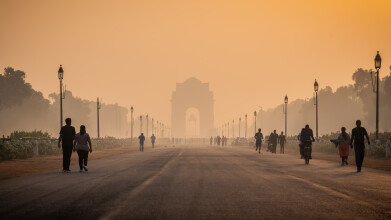Ambient air quality
Most air polluted region sees significant improvement in one year, says report
Sep 02 2024
South Asia has long been recognized as the region with the worst air pollution in the world, significantly impacting public health and reducing life expectancy. However, a recent report from the University of Chicago’s Energy Policy Institute (EPIC) highlights a surprising 18% decline in air pollution levels across South Asia in 2022, driven largely by favorable meteorological conditions. Despite this improvement, the region continues to grapple with dangerously high pollution levels, which remain a major public health threat.
For the first time in two decades, South Asia experienced a notable decline in air pollution levels in 2022. This unexpected improvement was recorded in all South Asian countries except Sri Lanka, with reductions observed in particulate matter (PM2.5) concentrations—a critical indicator of air quality. Bangladesh saw the steepest decline, with PM2.5 levels dropping by over 15 micrograms per cubic meter (µg/m³), followed by India and Nepal, where concentrations fell by approximately 9 µg/m³.
The report attributes this decline primarily to favorable weather conditions, particularly above-average rainfall across the region. Increased rainfall likely helped to clear the air of pollutants, reducing the levels of harmful particulates. However, experts caution that these meteorological factors are temporary, and sustained efforts are needed to achieve long-term improvements in air quality.
Despite the temporary improvement, air pollution in South Asia remains alarmingly high, with PM2.5 levels still averaging 41.4 µg/m³—eight times higher than the World Health Organization’s (WHO) recommended safe levels. The report emphasizes that the region’s residents continue to lose more than 3.5 years of life expectancy on average due to poor air quality. In heavily polluted areas such as Peshawar and Lahore in Pakistan, life expectancy is reduced by more than five years.
Air pollution remains the single largest environmental health risk in South Asia, comparable to the health impacts of smoking. The AQLI report highlights that in some areas, pollution shortens life expectancy more significantly than HIV/AIDS, tuberculosis, and malaria combined. This underscores the urgency of addressing the region’s air quality issues through coordinated policy actions.
Efforts to combat air pollution in South Asia face numerous challenges, including the lack of comprehensive air quality data and limited enforcement of existing policies. Many countries in the region have inadequate monitoring infrastructure, leading to a vicious cycle where the lack of data hampers policy development and implementation, further exacerbating the problem.
In addition to inadequate data, the rapid industrialization and population growth in South Asia have driven up energy demand, leading to increased reliance on fossil fuels. The number of vehicles on the roads has quadrupled in countries like India and Pakistan since the early 2000s, significantly contributing to air pollution. The practice of burning agricultural waste, particularly in India, further exacerbates the problem, with stubble burning accounting for a substantial portion of seasonal pollution in the region.
The slight improvement in air quality observed in 2022 offers a glimmer of hope, but experts agree that sustained and coordinated efforts are essential to achieving long-term reductions in pollution. The report calls for enhanced monitoring, stricter enforcement of pollution control measures, and increased investment in clean energy technologies. In particular, addressing sources of pollution such as transportation, industrial emissions, and agricultural practices will be critical.
Moreover, the report highlights the need for regional cooperation, as pollution in South Asia often transcends national borders. Collaborative efforts to implement cross-border air quality management strategies and share data could significantly improve the effectiveness of pollution control measures across the region.
While the decline in air pollution levels in South Asia in 2022 is a positive development, it remains to be seen whether this trend can be sustained. The region still faces significant challenges in improving air quality, with millions of lives at stake.
Digital Edition
IET 35.2 March
April 2025
Air Monitoring - Probe Sampling in Hazardous Areas Under Extreme Conditions - New, Game-Changing Sensor for Methane Emissions - Blue Sky Thinking: a 50-year Retrospective on Technological Prog...
View all digital editions
Events
May 10 2025 Karachi, Pakistan
May 11 2025 Vienna, Austria
May 11 2025 Seoul, South Korea
Salon Analyse Industrielle & Instrumentation
May 14 2025 Paris, France
May 15 2025 Istanbul, Turkey






_(4427399123)-(2).jpg)












